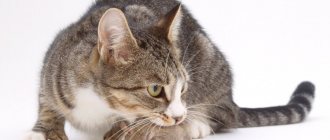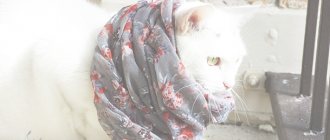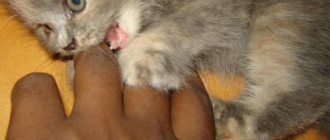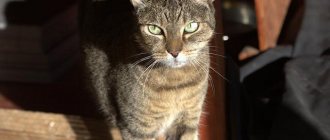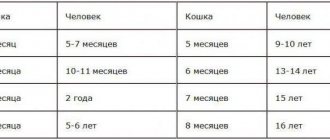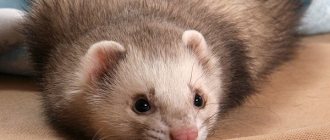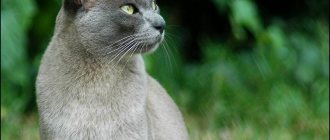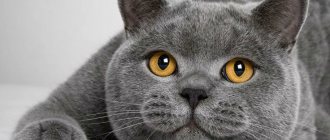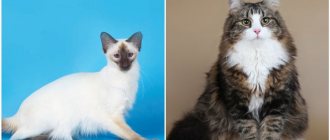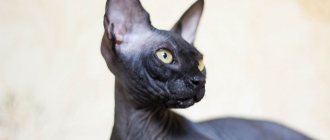History of the origin of the domestic Bengal breed
global $ads_google;
//data-ad-slot=”2475549904″ $ads_google = empty($ads_google) ? false : true; ?> if ($ads_google == false) {?> $ads_google = true; ?> } ?> The goal of breeding the Bengal cat, the founder of the breed, American Jane Mill, considered obtaining a domestic cat that preserved the color of its wild ancestors - this would help focus attention on the serious problem of extermination of leopard cats.
The history of the origin of the Bengal breed began almost 60 years ago, in 1961, when Jane came to Bangkok. This trip became fateful: there she received a baby Asian leopard cat, which is almost impossible to tame. The purchased baby received the name Malaysia and settled down with the new owner. The grown cat gave birth to offspring from a domestic shorthair cat, but the vicissitudes of fate did not allow her to start breeding a new breed.
A new attempt was made by Jane in 1980. She was provided with 9 hybrids of a leopard cat and domestic cats of different breeds. Then Mill fell into the hands of an Indian cat with a golden-orange color, which gave the Bengals a shiny coat called glitter.
The work was long and difficult due to many factors, and ended in success and recognition by the early 90s.
Description and standards of Bengal cats
It is impossible not to notice the external features of an exotic cat. Even when very small, the baby Bengal looks like a leopard. An adult Bengal cat receives the highest reviews and, just from one verbal description, is a true beauty.
According to the WCF standard, the breed must have a number of characteristics.
The head is a wedge with a massive chin and thickened chin pads. Thanks to this structural feature, the animal’s muzzle resembles a tiger’s mouth. This similarity is even more noticeable during yawning, meowing or growling.
The ears are short and set high on the head. They are wide at the base and their tips are rounded.
The nose is large, curved and moderately wide.
The eyes are almond-shaped and very beautiful. Eye color is clear green or golden.
The head is located on a thick and strong neck, which is in ideal proportions in relation to both the head and the body.
A cat of this breed has a large body and strong muscles.
Bengals run around the house on round, large and powerful paws. As usual, the length of the hind legs exceeds the length of the front ones.
The tail is medium in size, does not fluff, and is dense to the touch. The domestic leopard's tail has spots or rings.
Bengals are short-haired creatures with a soft, silky coat.
When interested in a description of a particular cat breed, people who are allergic to the Fel D1 protein first of all find out whether this charming creature is a hypoallergenic animal. Despite the fact that shedding almost does not affect these cats, they themselves carry the entire allergen on their skin.
global $ads_google; //data-ad-slot=”2475549904″ $ads_google = empty($ads_google) ? false : true; ?> if ($ads_google == false) {?> $ads_google = true; ?> } ?>
The breed presents a wealth of colors. A popular color is spotted-striped. This variety has shades of gray, white or red.
The most common and characteristic color of the Leopardette breed makes the cat look like a leopard.
“Sorrel” in cats finishes forming closer to the year. The coat is golden, the spots are chocolate brown, and the tip of the tail is black.
A sign of the marbled variety is spots of a peculiar, non-leopard shape.
Cats in white and gray colors are called "snow leopards". Kittens are born white, only later acquiring their characteristic color.
The colors of the Bengal breed also be called: rosette on gold, rosette on silver, marble on gold, marble on silver, seal links point, seal mink, seal sepia, charcoal, blue.
Glitter and phasing in Bengal kittens
Fazing in Bengal kittens is the process when babies from one month to four months are covered with gray or dull white fur. The name of the process comes from the English word fuzzy - unclear, uncertain. When the baby is more than a month old, the owner suddenly notices that the appearance of the young Bengal is changing. His fur becomes strewn with protruding whitish hairs, and the cat looks shaded. If phasing is severe, it makes it very difficult to see the pattern and color of the skin. The full beauty of the fur coat returns to eight months of the animal’s life.
Phasing does not manifest itself in every Bengal kitten.
The breed is characterized by glitter - a particularly strong shine to the coat. This is not a mandatory parameter for exhibitions; you can purchase a cat with or without glitter, since the standard allows both types for all representatives of the breed.
Dimensions and weight of Bengals
When buying such a pet for a home, the owner should imagine how big a Bengal cat grows. The height of an adult animal at the withers is 40-41 cm. The animal grows to this established norm by 1.5 years, but the complete completion of growth processes is completed by the age of two years.
The typical weight of purebred cats is 3.5-5.5 kg. An adult male is more massive than a female and weighs 5-8 kg. Animals of both sexes are larger and smaller than the declared weight, but this does not happen often.
If a cat seems very large and its weight is quite high, this does not mean that obesity has appeared: Bengals are nimble and energetic creatures, and, most likely, their body weight is due to the pet’s excellent physical shape and well-developed muscles.
The body length of an adult handsome leopard is about 90 cm, and the height at the withers is 40-41 cm.
global $ads_google;
//data-ad-slot=”2475549904″ $ads_google = empty($ads_google) ? false : true; ?> if ($ads_google == false) {?> $ads_google = true; ?> } ?> Table of weight of Bengal cats by month
| Age | Female | Male |
| newborn | 65-110 gr | 70-125 gr |
| 1 month | 350-500 gr | 390-560 gr |
| 2 months | 640-1100 gr | 750-1300 gr |
| 3 months | 1.2-1.6 kg | 1.3-2.2 kg |
| 4 months | 1.7-2.6 kg | 2.5-3 kg |
| 5 months | 2.5-3.1 kg | 2.8-4 kg |
| 6 months | 2.8-3.9 kg | 3.1-4.3 kg |
| 8 months | 3.2-4.8 kg | 3.7-5.1 kg |
| 10 months | 3.3-5 kg | 4.3-5.6 kg |
| 1 year | 3.4-5.2 kg | 4.8-6.3 kg |
| 2 years | 3.5-5.5kg | 5-8 kg |
Characteristics of this breed
Bengals are difficult to breed, which is why the breed is rare and expensive. Bengals are the most talkative of all domestic cats.
Be sure to read:
Sizes and weight of a Bengal kitten by month: table, norms and what to feed to gain weight
They can not only purr and meow, but also make about 100 unique sounds. If an animal gets angry, it will growl. Only Bengals can do this.
Cats of this breed are not afraid of water, and many even like to swim. This is the kind of “love” that Bengal cats have from their wild relatives. They lived in Asia, where there were many lakes, rivers and other bodies of water.
Size and weight gain
Cats are much larger than cats. After reaching puberty, the male becomes twice the size of the female. With a height of 90-100 centimeters, the weight of the cat is 8-9 kilograms.
Cats gain up to 5 kilograms. Bengals have a long, muscular body and strong legs.
Shedding
Bengal cats are short-haired, so with the right diet they practically do not shed.
The glitter on the Bengal fur should be pronounced, the fur should look like mink fur
Active hair loss can be triggered by a deficiency of vitamins due to an unbalanced diet or sudden changes in hormone levels.
Allergy
Many breeders say that Bengal cats cannot cause allergies. However, in the saliva of any cat, regardless of breed, there is a specific protein, which provokes a histamine (allergic) reaction.
Characteristics of Bengal cats
The appearance of a Bengal kitten in the house expands the horizons of its owners and narrows their horizons to raising one nimble little rascal. The cat's character is bright and memorable: the combination of the natural intelligence of a predator merges with the soft playfulness and sociability of its domestic ancestors.
Reviews about domestic leopards are similar in that these cats are extremely intelligent creatures, so raising and training them is a pleasure. The family favorite remembers commands easily. It doesn't take long to train your Bengal to use the litter box.
The cat’s adaptation to new conditions occurs quickly; very soon the baby will explore all available places and begin to explore forbidden areas. You can compare the character of a Bengal with the character of dogs - he is just as ready to defend his territory, protect his owner, and carry objects from place to place. During the game, the Bengal pet will easily return the abandoned toy, since he himself is interested in spending time with the owner or his child in this way, which is why it is recommended to train the cat.
global $ads_google; //data-ad-slot=”2475549904″ $ads_google = empty($ads_google) ? false : true; ?> if ($ads_google == false) {?> $ads_google = true; ?> } ?>
Cats welcome the company of their beloved household members and are very talkative, but you should not cuddle the animals. Cats are also good with other domestic animals and can make friends with dogs. Bengal girls are well socialized, but they do not approve of communicating with strangers - they need time to understand whether a person entered the house with good intentions.
The animal picks up the mood of its owners very accurately, reacts sensitively to changes in tone of voice, and remembers the words addressed to them.
Raising a cat should start as early as possible. Bengalis are very socialized, they learn understanding and learn about the world from a person's voice. In addition, these cats, like dogs, remember words and are able to follow commands.
They regularly devote time to raising the spotted cat, mainly by playing with the young predator. The game allows the Bengal pussy to show the predatory instincts of a hunter and learn an acceptable behavioral model. Aggressive actions of a cat must be stopped, so it is important to know how to properly raise a cat.
Bengal cats definitely need physical exercise: cats' access to heights is encouraged.
Care and feeding of Bengals
A short-haired cat brings less worries at home than its long-haired counterparts, which makes caring for your pet much easier. Keeping and caring for a cat is not difficult: 2-3 times a week, devote a little time to combing the fur, which a soft rubber brush will help with. Sometimes you may not even notice the shedding, but once the procedure has begun, it is better to comb the kitty more often.
The descendant of a wild leopard cat needs to trim its claws once every couple of weeks. The ears are cleaned at the same intervals with a damp cotton pad.
It is also necessary to take care of your pet's oral cavity by brushing its teeth once a week.
The bath easily becomes a favorite place for the Bengal, who happily hits the water with his paws. Washing is allowed in rare cases using special cat shampoos.
Feeding a Bengal kitten occurs from month to month according to the feeding schedule and recommendations of specialists. Good nutrition quickly turns a small cat into a healthy, strong cat.
What to feed a Bengal kitten for 2 months
They also feed raw meat (beef or rabbit), exclude raw offal from the diet, replacing them with boiled sea fish once a week. Dairy products in the form of kefir, baby cottage cheese without any additives, and low-fat cream are useful for cats. The daily food intake also involves the addition of vegetables not exceeding a quarter of the volume of meat products. These are carrots, tomatoes, bell peppers. A Bengal cat can be switched to premium and super premium dry food, which the animals eat with benefit and pleasure.
Keeping a neutered cat involves replacing natural nutrition with specialized food.
Lifestyle
Their habitats are:
- tropical or pine forests;
- semi-deserts;
- area near rivers;
- territories located at an altitude of 3000 m above the ground.
Wild Asians build their homes in:
- tree hollows;
- caves;
- dens.
In their natural homes, Asian cats mostly sleep during the day, as they are nocturnal, hunting for other animals, because they are predators. To do this, they easily climb to the tops of trees, hoping to find food there, which for them is:
- small birds;
- proteins;
- tree shrews.
INTERESTING TO FIND OUT: Who is the Cheshire Cat? Character Quotes
These cats often live near bodies of water, so their diet may include various members of the amphibian family. They feed on insects, mammals, and lizards.
Leopard cats living in the northern regions love to eat fish, eggs, catch hares, and sometimes eat grass.
If desired and necessary, they can swim in rivers, climb mountains, even climb rocks. These predators are usually solitary. They are rarely seen near human habitation. They prefer to spend time in pairs only during the mating season, after which 2 or 3 kittens are born.
A pair of cats that have offspring usually raise children together for 8 months. Evidence that kittens are predators is the presence of fangs within a month after birth. By this age they are ready to taste solid food.
Health of the Bengal cat breed
Fortunately, thanks to breeding work and natural hereditary immunity, Bengal exotic beauties have excellent health indicators. But if their immunity resists most feline diseases, then there are some genetic diseases, the fight against which in many cases is quite successful.
global $ads_google; //data-ad-slot=”2475549904″ $ads_google = empty($ads_google) ? false : true; ?> if ($ads_google == false) {?> $ads_google = true; ?> } ?>
The most common phenomenon is “dry nose syndrome.” This problem can occur in kittens up to one year of age. You can't miss a dry nose: cracks and crusts on the surface of the nose become ulcers. In general, this condition is not critical to health and does not cause any special problems for the animal itself. To know for sure whether a dry nose promises trouble, it is better to consult a veterinarian - it happens that this condition develops into an ulcerative lesion of the nose. The doctor prescribes timely treatment that will help restore the healthy state of the nasal surface.
Bengals are sensitive to poor quality food, so to avoid loose stools, the cat is fed only selected food and always provides the pet with fresh water.
There are two serious genetic disorders: hypertrophic cardiomyopathy (HCM) and flat chest syndrome (FCK) in kittens. In the first case, observations and testing are mandatory; proper care will allow the cat to live a long and good life. The second problem is a serious obstacle to the survival of kittens and is looking for a solution. If a Bengal cat was taken from a cattery with a good reputation, where inbreeding and the use of antibiotics by the pregnant female were not allowed, the problem is unlikely to affect her and her offspring.
Miniature leopards are vaccinated according to a schedule starting at 8 weeks. All vaccinations are prescribed by a veterinarian.
The life expectancy of a healthy Bengal cat is 14-16 years if it lives under the supervision of attentive and caring owners.
If the cat was taken as a family pet, then you need to monitor the onset of puberty in order to castrate or sterilize the animal in time. The first heat in a Bengal cat occurs at 6-8 months, when the female’s weight reaches 2.5-3.3 kg. Cats “grow up” by 9 months. If you want to get offspring from your pet, you need the obligatory assistance of a specialist in breeding, otherwise even a successful mating, healthy pregnancy and problem-free childbirth do not guarantee full-fledged offspring.
Description of the Asian leopard cat
Cats of this breed are distinguished by well-developed muscles and large size. The weight of males reaches 6–8 kilograms, cats weigh from 3 to 5 kilograms. A kitten from the “correct” litter should not be fragile - this is a distinctive feature of “Asians”. The body of a sexually mature animal is from 50 to 80 centimeters in length, the tail is about 30 centimeters.
The tail is massive, cone-shaped, with a rounded tip. The animal's head is relatively small, wedge-shaped with smooth, streamlined lines. According to standards, it should be elongated from the ears to the mouth, not wide in the frontal part. The ears are medium in size with round tips, slightly pushed forward. The eyes are oval, widely set with a clearly visible black border. The hind legs are necessarily slightly longer than the front legs, which corresponds to the wild origin of the cat. The figure of the animal is dense, muscular, and not visually heavy.
Buy a Bengal kitten
Nurseries where you can buy a Bengal kitten are quite common in Russia. You won’t be able to save money on buying a descendant of a wild Asian leopard cat if you want to buy a purebred animal that will strictly meet the standards. In the nursery, the buyer will learn all the information about the future cat, its pedigree, and hear interesting facts about the character of the domestic mini-leopard.
The cost of the Bengal remains high precisely because of the difficulties with breeding. The first generation of Bengals will be infertile if they are males. Females of the first generation are crossed with Bengals and a second generation is obtained, where most of the males are sterile. In the third generation from the f2 female, only some males are sterile. The fourth generation are considered true representatives of the Bengal breed, and have a full range of characteristic skills and traits.
The price for a Bengal cat in Russia is:
- pet class
25,000-50,000 rubles; - breed class
50,000-100,000 rubles; - show class from
100,000 rubles
.
What to name a Bengal kitten
When a Bengali boy or girl arrives in the house, the family may have a number of names ready. But before you give the kitten a nickname, you should know that it must begin with the same letter as the name in the passport.
global $ads_google; //data-ad-slot=”2475549904″ $ads_google = empty($ads_google) ? false : true; ?> if ($ads_google == false) {?> $ads_google = true; ?> } ?>
Also, you should not give a new cat the nickname of your previous pet, this is not only a bad omen, but also a careless attitude towards the memory of a deceased or missing pet.
A long name is difficult to pronounce and difficult for a cat to remember. Hissing sounds are welcome, to which the cat will react most quickly. You can experiment and try calling the cat by different names. There is a chance that the animal will choose its own name.
Handy tables have been created with names that might be suitable.
| Girl | Boy | ||
| Julie Dosya Cleo Dotty Shelma Ivy Eva Aida Stesha Fanta Vikki Iksa Yesya Lika Liya | Almira Brandy Toffee Yuni Tori Lynx Klepa Cher Goldie Ulfi Bara Baksa Goldie Lucky Finka | Joshua Joe Alistair Leo Easy Bingo Ike Luntik Wirt Tory Rain Ride Whiskey Martin Ralph | Vince Rick Jacques Mort Indie Byte Drake Knight Spot Fima Gore Chen Zipper Gizmo Weiss |
Conclusions about the breed
The Bengal cat deservedly receives praise and admiration, but not only due to its chic external characteristics:
- The cat's character is ideal for sociable and sensitive people. Both adults and children can play with the furry baby;
- if the owner does not have time to care for the cat, then it is better to opt for a less demanding breed;
- without experience it is not worth breeding cats;
- a well-developed intellect only pleases;
- the cat does not like to be squeezed;
In general, Bengals have good health and delight with their intelligence.
Breed character and habits
There is a myth that Bengal cats have uncontrollable behavior. It is not true. Modern Bengals are adapted to living in apartments and private houses.
Activity is due to the innate instinct of the hunter. The best toys for Bengal cats are a ball, a laser, a wind-up mouse. Cats prefer active games and can endlessly chase “game”.
Be sure to read:
Short-legged Munchkin cat breed: maintenance and care, health and cost of kittens
Keeping Bengals with dogs or rabbits at the same time will not cause trouble for the owner. And the cat will immediately begin hunting for rats, hamsters and parrots.
A small kitten should be picked up as often as possible and not left alone. Otherwise, the adult will resemble a wild animal.
